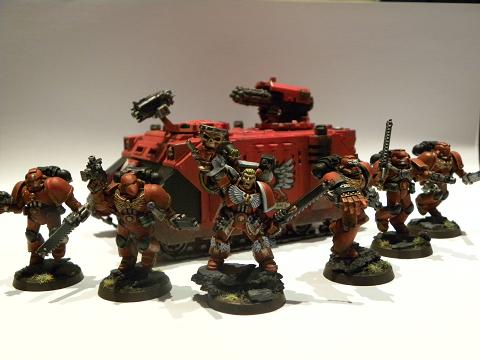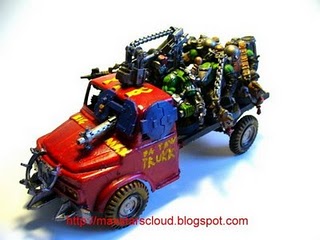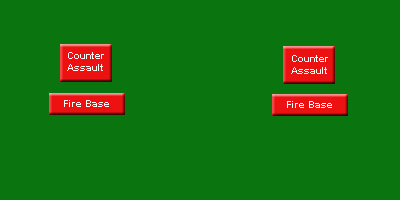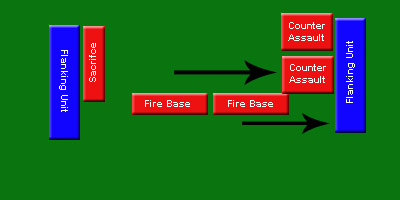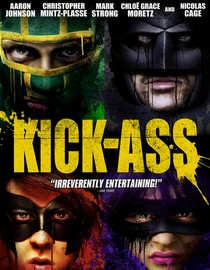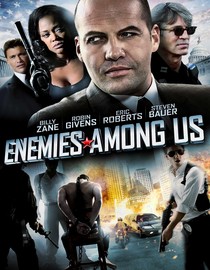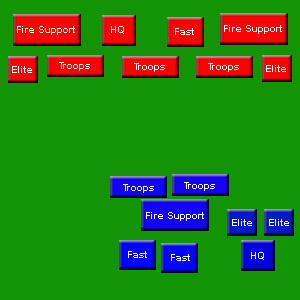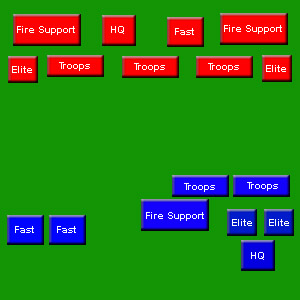Anyone that listened to the "Spencer, Scott & Chipley" days of the 40k Radio probably remembers those days quite fondly. The chemistry between the hosts was good and there was always some interesting content. While at the end of the show's days the casts tended to consist of three or four guys getting drunk and making fun of each other, the stuff they produced towards the middle of their run truly was good stuff. In fact, the quality and production value of 40k Radio's content set that show apart as what a 40k podcast should strive to become -- love it or hate it, it was the gold standard that inspired many of the podcasts to come.
Unfortunately, the show came to an end following a ridiculous melodramatic display of immaturity. I mean, we're talking about three guys sitting in a basement, drinking beer, and talking about playing with toy soldiers. It ended with a toilet flushing anthem that would have been more appropriate for an all-geek episode of 'Jerry Springer.' It was embarrassing for the listeners, and it was a palpable loss to both the pod-casting community, and to the 40k community in general.
And then came Romeo and Battle Foam to "save" the 40k brand. Or, at least, that is probably the ultimate goal, but they've got a LONG, long way to go...
A Rocky Start
Resurrecting the gold standard in 40k pod-casting is certainly not a feat for the feint of heart. But it's also turning out to be
much more challenging than Romeo probably expected. I mean, let's face it, given the embarrassing collapse of the original (full of finger pointing, not-so-secret secrets, message board flame wars, racism, and high school emotional hi-jinks) he probably thought it would be easy: find some mildly amusing hosts, maybe a voice from the old show, and try not to sling the 'N' word while streaming live. Sounds pretty simple, but the new show is still limping along very slowly... In fact, the "voice from the old show", George Miller, has already left... and they were only four shows into the new run! And now, some 9 shows in, they are still showing some growing pains.
After sitting through 8 of the new shows, I kind of wonder when this crew is going to get their act together. I can think of several shows that were able to get their feet under them in just a handful of shows, and are moving along quite well: The Independent Characters, Tabletop Hooligans, and Life After the Cove Save just to name a few. In fact,
all of these shows are at right about 10 shows in, and they have found their own unique voice. You may not
enjoy their voice, but they are certainly consistent and they are all definitely doing their own thing. 40k Radio, on the other hand, really hasn't settled on a voice. They
appear to be moving in the direction of being an 'Interview' show with just a handful of "what have you been doing in the past week" segments thrown in there for good measure. But random elements come and go, which makes me think they really aren't sure what they want to keep and what they should purge.
The Real Problems
Besides not having a constant voice, there are a few consistent problems that the show doesn't seem able to overcome. Unfortunately these really aren't small problems and go towards the core of the program. And unless the show finds a 'fix', they probably won't last...
Poor Technology: 40k Radio has always been known for leading the way when it came to technology. They had a legendary forum, and they were one of the first to adopt a quick and easy web format to show viewers what shows were coming up next. Even more important, the quality of their shows was second to none -- great sound equipment, and cut very, very well. And then we have the new version...
The current iteration of 40k Radio is simply
not up to snuff when it comes to the technology of the show. For instance, episode 9 just posted, but when you look at the 'show host' section of the website, George Miller is still listed as the first chair host! He's now been gone for more shows than he was ever in, and no one has bothered to update the website. Not that we should be too terribly surprised. I'm sure the same web team that cobbled together the clunky Baggy's Brigade site, which has a very thinly veiled paintball community skeleton, is also taking care of the 40k Radio site. Like Baggy's site, there are non-functioning elements, the pages are not updated, and it just looks very dated. Contrast that with The Eternal Warriors (formerly Dice Like Thunder) and their own swanky collection of pages, and 40k Radio is really, really falling behind. On the up side, their broadcasting is certainly getting better, but even episode 8 was posted with Romeo's countdowns to 'action' between segments.
Rampant Inaccuracies: 40k Radio, especially at the end of the show's run, was never the perfect keeper of 40k lore. Short of reading the codex over the air waves, they screwed things up all the time. But by the end of a segment, someone would pick up the book, read the
correct interpretation of the rule, call the speaker a moron, and they would move on. Unfortunately that tradition has carried forward into the next iteration of the show -- at least, the part where they get things wrong...
I love the 40k fluff, but I certainly don't know it all. But I
realize that I don't know it all and wouldn't pretend otherwise. It annoys me to hear Ravenguard referred to as Night Ravens...repeatedly. It annoys me when they offer up tactics that are essentially illegal because they're forgetting special rules (or universal special rules) that have been around since the initial publishing of 5th edition). Why does it annoy me so badly? Because the segments are
supposed to be informative and not just speaking off the cuff. How can you review the latest Forgeworld book and then keep forgetting (or at least woefully mispronouncing) the name of the only Space Marine chapter featured in it? If a segment is supposed to be a "prepared" review then the hosts should do their homework. Period. Anything else just smacks of unpreparedness. No, they're not professional journalists. But if they're going to give a review, then they need to know what the hell they're talking about. If, on the other hand, they want to be three guys shooting the shit about the latest Forgeworld book, then that's something else entirely. But that's not the image they're trying to portray. They need to pick a path and go there... and someone should probably read the codex ahead of time rather than everyone pretending to be an expert with their own version of half remembered rules.
Poor Chemistry: The old 40k Radio consisted of three or four friends sitting around the microphone and talking about toy soldiers. They gelled well, and they played off of each other like good friends do. Inside jokes became common knowledge for the listeners, and it was easy to get sucked in. The current 40k Radio just doesn't have that.
It is painfully apparent when you listen to these three chat that Rik and Kyle work for Romeo and Battle Foam. I'm sure Romeo gave them the freedom to take the gloves off when they're on the air so that they don't 'pay' for any on air jibes at the boss man when the radio is turned off, but the result is just really, really bad. Rik and Kyle come across as wanting to get their digs in at the boss while they can and often go way over the top to harass Romeo. In fact, it's so bad that Romeo, on air, has to tell the guys to knock it off and get back on track so that every episode doesn't become a Romeo slam-fest. Who wants to listen to that?
But really, I think the chemistry problems are not just boss/employee related. Rik and Kyle often come across as mind numbingly immature. Fart jokes - check; over-the-top homophobic butt-sex jokes - check; fat jokes - check; inappropriate and gratuitous cursing - double check; and most importantly, screwing around with your co-host while someone else is trying to tell a story or share information with the listener making it hard to hear what anyone is saying - got it! Is this a podcast or a high school locker room? Don't get me wrong, it isn't that I think that Rik and Kyle don't have anything to add. In fact, generally, just when I get to the point in a podcast where I think I need to personally email Romeo and recommend that he fire one of the two morons to improve the podcast's quality, one of them will actually contribute an actual insightful comment that saves the discussion.
This tells me that all the screwing around is just not necessary. The Tabletop Hooligans and Life After the Cover Save have got the screwing around 40k podcast genre covered -- and they're much funnier and work together MUCH better. Why 40k Radio is trying to horn in on this genre is confusing to me. What the podcast community really lacks is a wealth of podcasts that are genuinely contributing to the hobby in an insightful manner. DLT/TEW does it. 11th Company does it. But it would be really nice to see more of them get to that level. The Hooligans and the Cover Save crew are not going to be that voice, and frankly, I prefer their own unique brand of hi-jinks (although Hooligans have devolved a little bit of late...). 40k Radio presents itself as trying to be serious, and then the hosts talk over each other trying to see who can spout the lamest put down. It doesn't work, and it comes across as a mess. The hi-jinks are NOT 40k Radio's strong point. Besides, who wants to be a morning radio style hack show? Nobody wants to listen to that.
Unfortunately, I think that 40k Radio is getting the wrong message from their feedback. I think they're mistaking the positive comments they receive as supportive of ALL of the content they provide rather than just the shining moments that sometimes emerge from the childish crap. When they're on, they are really on and it is good to listen to. But the ridiculousness that they cram into every episode can be a bit much to take. If you put aside the parts of their show where they're trying to be funny, then the content looks promising. Unfortunately, that's only about half of the 3 hours of podcast they put out. It's a lot to dig through to get to the gems.
I don't think 40k Radio is beyond hope, but they've got to get their act together. The hosts need to prepare their segments. They need to clean up the technology (someone should probably take a look at the website and dump the crap that shouldn't be there any more -- sometimes less is more). But most importantly, Rik and Kyle need to drop the kindergarten act and start contributing intelligently. I'm not saying they need a stick up their backsides (like Romeo sometimes appears to suffer from), but it would be nice if they would dump the crap.












